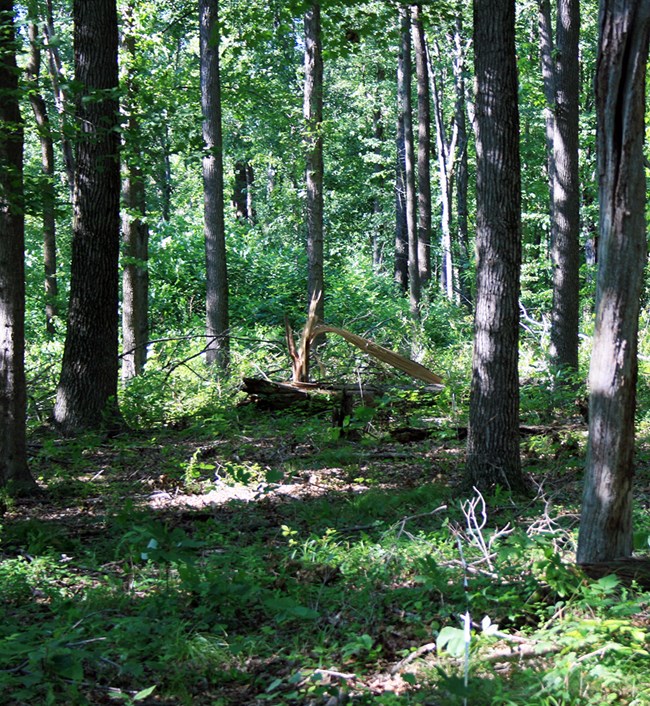Last updated: September 10, 2025
Article
Forest Plant Community Monitoring at Lincoln Boyhood National Memorial

NPS
Forests at the Memorial
Lincoln Boyhood National Memorial includes 200 acres of old fields and hardwood forest. Land surveys from 1805 show that the area was covered in an oak-hickory dominated forest with beech, black cherry, flowering dogwood, elm species, gum, shagbark hickory, ironwood, black locust, sugar maple, oak species, tulip poplar, pawpaw, redbud, sassafras, sycamore, and black walnut. When Abraham Lincoln's family arrived, they began to clear the land for agriculture. Only small woodlots on the hilltop cemetery remained.
When the memorial was established, it was decided that the forest should be restored to provide visitors with a sense of what early settlers faced as they developed the land. Almost 40,000 trees and shrubs were planted using the 1805 survey as a guide. The Heartland Inventory and Monitoring Network monitors the species composition and structure of the forests to determine their current condition and to understand how they might be changing over time.

NPS/Paula Alexander
Monitoring the Forests
Heartland Inventory and Monitoring Network scientists have monitored forests at the Memorial since 2011. Four monitoring sites were established in the southern part of the Memorial and sampled in 2011, 2015, and 2019. The sites represent a mix of successional hardwood forest and the old homesite restoration.
We record the tree species found, their diameter at breast height and basal area (based on the cross-sectional area of tree stems at breast height), the number of seedlings and saplings, the tree status (live or dead), and how closed the tree canopy is. For other types of plants in the forest, we record how much ground area each species covers ( a measure called plant cover that is an estimate of abundance).

NPS
Forest Plants
(2011–2019)
Trees
Forests on the Memorial have a closed canopy. Large trees (greater than 45 cm diameter at breast height) made up the greatest amount of tree basal area. Sugar maples (Acer saccharum) had the greatest basal area and density of the 23 tree species found. Of the 17 tree species recorded in the regeneration layer (seedlings and saplings), the three that were most abundant over the monitoring period were sugar maple, red bud (Cercis canadensis), and ash (Fraxinus spp).
Ground flora
The diversity of plants in the lower layer of the forest (ground flora) was similar through time, but diversity by site and by community were slightly higher in 2019. Plant guilds varied through time—the most abundant guilds were native woody plants and forbs (flowering, non-woody plants that are not grasses or grass-like). Other plant guilds include grass, grass-like (rushes and sedges), fern, and vine.
Nonnative plants were also a part of the ground flora composition. Common periwinkle (Vinca minor) and Japanese honeysuckle (Lonicera japonica) continued to be the most abundant nonnative species but have decreased since 2011. Treating of nonnative plants is an ongoing management challenge at the Memorial.

NPS
Did You Know?
When young Abraham Lincoln and his family arrived at this site in the early 1800s, it was largely an oak-hickory woodland. Reestablishing the dominance of oaks and hickories is a management goal for the Memorial. Canopy openings are necessary for this type of forest to grow, but our monitoring found that the forests have closed canopies. Opening the canopy so oak trees and other herbaceous plant species can establish and thrive is an ongoing management challenge. However, the forest that exists here today meets the Memorial's hopes of providing visitors with a visual representation of the challenges the Lincoln family faced in clearing the forest and settling their homestead.
For More Information
View the Full Report.Visit the Heartland Inventory & Monitoring Network website.
